Additive’s Moldmaking Potential
Mazak’s recent “Discover” event shed light on potential applications for metal-cutting machine tools with integrated laser-cladding heads.
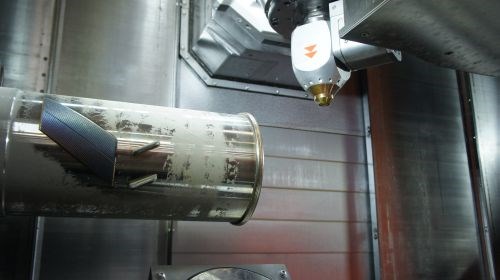
A view inside the workzone of the Mazak Integrex i-400AM turn-mill, which features two varieties of laser cladding heads that can be mounted in the toolchanger. This technology enables building up geometry layer-by-layer (examples are visible on the workpiece shown here) in addition to traditional milling and turning operations.
Although moldmakers can certainly make use of turn-mill machines, our sector of the industry probably wasn’t top of mind for Mazak when it designed the Integrex line. Nonetheless, one model making its North American debut at the builder’s recent “Discover” event, hosted October 27-29 and continuing November 3-5 at its Florence, KY manufacturing campus, got me thinking about how other machine designs incorporating similar technology might impact our corner of the industry.
That technology is the addition of laser cladding heads, capable of building parts up layer-by-layer, that can be mounted in the toolchanger of the new Integrex I-400AM like any common cutter. For the Integrex line, this adds yet another capability to a “done-in-one” machine concept that already incorporates a full five-axis milling spindle, a turning spindle with full C-axis contouring, and a fully programmable tailstock.
However, the implications of hybrid additive/subtractive processing go beyond any particular machine type (for instance, we’ve already reported on laser welders incorporating cladding heads). With that in mind, I asked Joe Wilker, product manager, to speculate on potential mold manufacturing applications that could be made possible by mounting similar laser heads in the toolchanger of, say, a VMC.
The first is repair. On the Integrex, fiber laser heat melts metal powder, and the laser cladding heads apply this molten material layer by layer to “grow” near-net-shape 3D forms. Incorporated on a milling machine, such a system could enable building up worn portions of a mold and then machining to final finish in the same setup.
The second is the ability to incorporate multiple materials. After all, there’s no reason why the molten metal has to match the material in the rest of the workpiece. Adding a layer of metal that’s more expensive or more difficult to machine could potentially help meet customers’ mold specifications while significantly reducing material and/or tooling costs.
Although my conversation with Wilkers was brief, informal and speculative, other technology on the floor of the massive open house event is already being widely employed in the field. One notable example is the Mazatrol SmoothX and SmoothG CNCs, part of the company’s Smooth digital technology platform. Notable features include smooth corner control, which adjusts toolpaths to reduce vibration and reduces cycle time in corners; variable acceleration control, which reduces machining time by optimizing acceleration/deceleration control for a combination of axes; and smooth machining configuration, which enables adjusting for the type of machining and using custom settings.
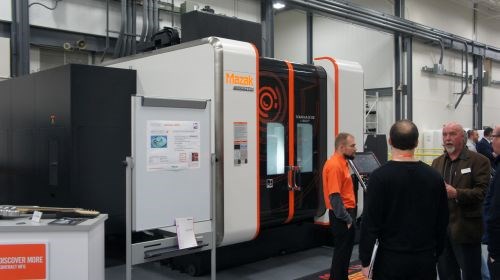
Mazak’s Variaxis line of five-axis machining centers is among the many offerings incorporating Smooth technology. Newer variants, such as this i-800T, feature trunnion-style tilting tables that can index 360 degrees and spin as fast as 800 rpm to provide full turning capability as well.
There’s a great deal more information about Smooth technology’s myriad other features and benefits on the company’s website. I’d also encourage readers to head over to the blog of our sister publication, Modern Machine Shop, for editor-in-chief Mark Albert’s take on Mazak’s latest strides in implementing the “Industrial Internet of Things (IIoT)”—a concept that’s been referred to as the “next Industrial Revolution.” Specifically, Mark’s post covers the SmartBox, a device that's designed to ease the connection of machine tools to a Web-enabled, plant-wide network.

Shown here mounted to an Orbitec large-part machining center used in Mazak’s own manufacturing operations, the SmartBox is designed for maximum flexibility: it is designed to be integrated on virtually any machine without directly interfacing to the electrical cabinet.
Related Content
How Hybrid Tooling Accelerates Product Development, Sustainability for PepsiCo
The consumer products giant used to wait weeks and spend thousands on each iteration of a prototype blow mold. Now, new blow molds are available in days and cost just a few hundred dollars.
Read MoreHow to Supply Cooling to Additive Tooling
Additive tooling provides limitless options for cooling a mold’s difficult-to-cool areas.
Read MoreA 3D Printing Retrospective
A personal review of the evolution of 3D printing in moldmaking throughout the past 25 years.
Read MoreVIDEO: How can 3D Printed Tooling Improve Injection Mold Venting?
Proper venting is one of a mold builders toughest challenges as molders struggle to keep vents free flowing in production. Learn how to apply 3D printing to mold venting and the benefits of additive venting inserts.
Read MoreRead Next
Are You a Moldmaker Considering 3D Printing? Consider the 3D Printing Workshop at NPE2024
Presentations will cover 3D printing for mold tooling, material innovation, product development, bridge production and full-scale, high-volume additive manufacturing.
Read MoreHow to Use Strategic Planning Tools, Data to Manage the Human Side of Business
Q&A with Marion Wells, MMT EAB member and founder of Human Asset Management.
Read MoreReasons to Use Fiber Lasers for Mold Cleaning
Fiber lasers offer a simplicity, speed, control and portability, minimizing mold cleaning risks.
Read More.png;maxWidth=970;quality=90)









.png;maxWidth=300;quality=90)








.jpg;maxWidth=300;quality=90)
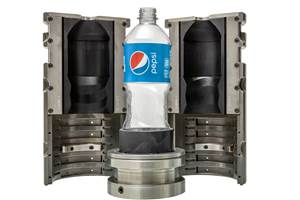

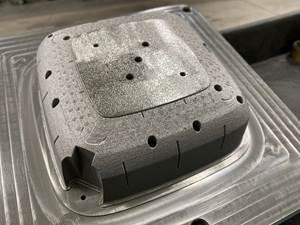
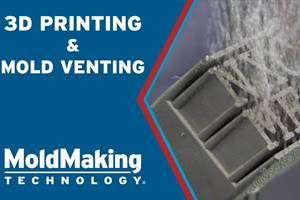



.jpg;maxWidth=970;quality=90)